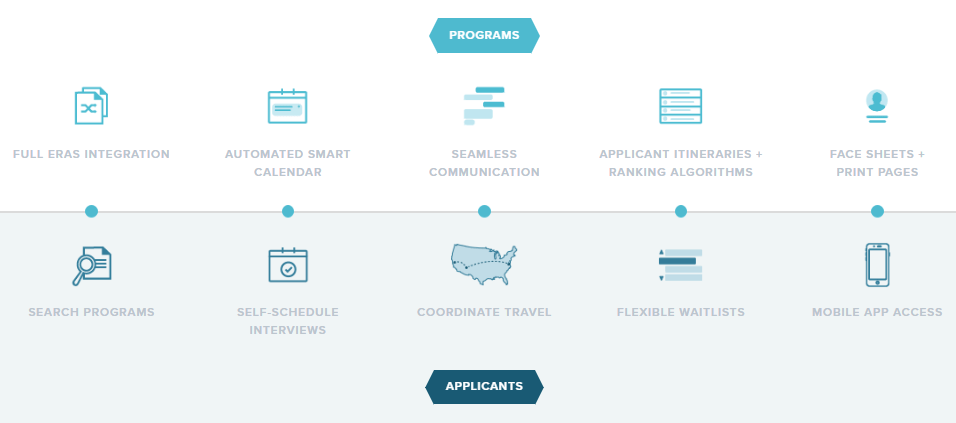Thalamus is the premier GME interview management solution. Now having completed our fifth residency recruitment season and NRMP Match, Thalamus has taken the lead as the most-preferred interview scheduling platform for applicants, program coordinators, program directors, and GME leadership.
How did we get to this position? What exactly does Thalamus do? And most importantly, how does it help both applicants and programs streamline the recruitment process?
Hi there, I’m Jason Reminick, MD, MBA, MS, the CEO and Founder of Thalamus, and a former applicant and resident myself. I can answer those questions! In this post, I will act as your guide as we provide an in-depth look as to how Thalamus became what it is today.
Where it all began
Flashback to October 2012, a few weeks after submitting my application to the Electronic Residency Application Service (ERAS). As I had a clinical interest in pediatric chronic pain, the planned application strategy was to apply to combined pediatric anesthesiology programs as a first choice, with either anesthesiology or pediatrics as my “backup specialties.” This lead to a jam-packed interview season, one that occurred well before online scheduling had become mainstream. Nearly all interviews were scheduled by email or phone call (and some, believe it or not, by snail mail!).
I was scheduled to start my interview season on October 30th, 2012, with several planned interviews in NYC over the next week. Having settled into my accommodations on the upper west side of Manhattan, all that was left was to prepare was some final review of materials for my first interview… and to witness just how truly devastating Hurricane Sandy would be as it tore through NYC (spoiler alert: It was really bad).

Lower Manhattan would end up underwater and without power. The NYC Marathon, after much debate, was canceled. Houses in Staten Island were being damaged; cars were floating away overnight. And the NYC subways were shut down due to significant flooding.

The ironic thing (or perhaps not, for those who have been through the residency interview process or worked in medicine in general), was that my interviews weren’t canceled until much later that day.
It was a nightmare. There was no framework for rescheduling interviews. One residency program even told me over the phone: “next time, make sure there isn’t a hurricane possible near your interview day…” Fortunately, things normalized, to an extent, and I was able to attend the first interview at the tail end of my trip, having literally been stranded in Manhattan for over a week.
But my heart broke that day when I learned that one of my co-interviewees had paid over $500 in cab fare to attend his interview that day. His house was destroyed, his car was washed away in the flooding and the program was unable to accommodate him in rescheduling to another interview day. It was his first choice program and he sacrificed everything to be there.
On the Long Island Railroad heading home, I was talking with another medical student who I met during the interview that day. We spoke a lot about the process and how there needed to be a much, much better way.
A week later I made my way back to my medical school in western NY where I had a meeting with my mentor (and now co-founder of Thalamus), Dr. Suzie Karan, about my application process. A residency program director herself, she had long envisioned a system allowing residency programs to streamline recruitment, having had to attract residents into western NY in the heart of winter (Note: lake effect snow is brutal).

As I needed one more course to complete my combined MD/MBA training on the business school side, we decided to do an independent study to write the business plan for what would become Thalamus.
Thalamus is born
One year later, after collaborating with mutual friends who were software engineers, we launched our beta for Thalamus on a Friday at 5pm. We had done no advertising, nor had we officially announced Thalamus’ existence to any applicant. Rather, our first customer invited roughly 350 applicants.
By Monday morning, interviews were filled to 99% capacity, a process that normally would have taken the program six weeks to complete. On the other side of the equation, the applicants could schedule their interviews in a matter of minutes. It was at that moment we knew we had something, and the rest was history!
Nineteen other anesthesiology residency programs used Thalamus that first season, to great success.
After raising a friends-and-family round of funding, we expanded our team and our product to all medical specialties. Five years later, we’ve now invited over 100,000 candidates in 67 specialties. Thalamus is used in 500+ residency and fellowship programs at 125+ of the nation’s top academic medical centers. In fact, 75% of all applicants use Thalamus to schedule interviews each season (and growing).
Our team is proud, humbled and amazed by how far we’ve come.
So what exactly does Thalamus do?
Thalamus is a two-sided platform that has features for both residency/fellowship applicants and programs—including (but not limited to):

Having lived through the process many times ourselves (as both applicants and administrators), we’ve built the product as part of a grassroots initiative of hundreds of applicants, program coordinators and program directors with specific “insider knowledge.” Our biggest competitive advantage is that “we’ve been there and done that,” and we have used our experience to optimize the interview management process.
In greater detail, Thalamus does the following:
- Programs sign up for Thalamus and create an account.
- Once the ERAS season opens, programs upload their candidates into Thalamus through a specific CSV integration.
- Programs set up their calendars including a scheduling algorithm allowing specific positions to be reserved for specific tracks (e.g. categorical, advanced, research, primary care, etc…), customize their emails and build survey questions.
- Programs then invite candidates, either in waves or as an entire cohort.
- Thalamus sends out invites via email with links for the candidates to build a profile in Thalamus.
- Within 20 seconds, candidates are able to create a profile which provides access to their Thalamus “Smart Calendar.” Similarly to Open Table, they can then sign up for available interviews in real time—including scheduling, cancelling, and rescheduling (until the program “locks” the interview date). We also have the most flexible waitlist management, as candidates can add themselves to any filled date while simultaneously remaining signed up for another interview date with each program. This gives applicants the freedom to create the most optimized schedule.
- Candidates can then book travel including airfare, hotels and rental cars directly through Thalamus while having their itineraries pulled back into our software so that their Thalamus account can act as a centralized hub during the interview season. All of these services are provided FREE OF CHARGE! We even have mobile apps for both iPhone and Android.
- On the program side, Thalamus manages all of the interview season data—including creating interview day face sheets, managing wait lists, running reports, building interview day itineraries and faculty scheduling, and even scoring, evaluating, and ranking candidates. The software also integrates directly with the NRMP for streamlined rank list management!
Using the above processes, Thalamus is innovating the way applicants and programs manage their interview seasons, including increasing ease of scheduling and decreasing overall frustration. Applicants can align their interviews regionally to decrease travel costs. Similarly, residency programs are saving 30-50% of their workload, so they can focus on the more critical and personalized components of recruitment.
You can find testimonials by candidates, and by residency and fellowship programs, here.
The future of Thalamus
Thalamus already brings significant efficiency to the residency and fellowship application process. However, we are most excited about what is to come.
It is no secret that the costs of the residency application process to candidates are spiraling well over $80 million/year. This is a 5x increase over the last 20 years, with the average US grad or International Medical Graduate applying to 60+ programs and 150+ programs respectively across all specialties.
The reasons for this will be covered extensively in another post, as well as strategies to alleviate such costs. However, to make a long story short, Thalamus is here to help!
We are now in a phase of rapid expansion and growth. This includes developing data and ranking products that will provide candidates greater insight into the recruitment process, and assessing their individual competitiveness. Additionally, we are building dashboards for programs to provide enhanced strategies for graduate medical education recruitment.
Our goal is to use data and technology to humanize the recruitment process and battle application inflation and anxiety. The current model is putting too much strain on everyone applying for residency, leading to early forms of burnout before candidates even begin training—something which is now in the national spotlight for GME programs.
Wait, Thalamus is going to do what? Yes, you read that right. We’ve collected hundreds of thousands of data points over a half decade of application and interview recruitment seasons. Through metadata and behavioral economics, we will be able to assist in providing greater insight to all stakeholders including applicants, GME programs, medical schools and policymakers.
We are thrilled about the future of Thalamus—be on the lookout for exciting announcements! In the meantime, we are always here to assist, so please reach out to us anytime.
To learn more about Thalamus and the ways in which it can be put to use, head over to our “how it works” page and click around. We are proud to make life during interview season easier for residency programs and applicants. Best of luck to all our users!
